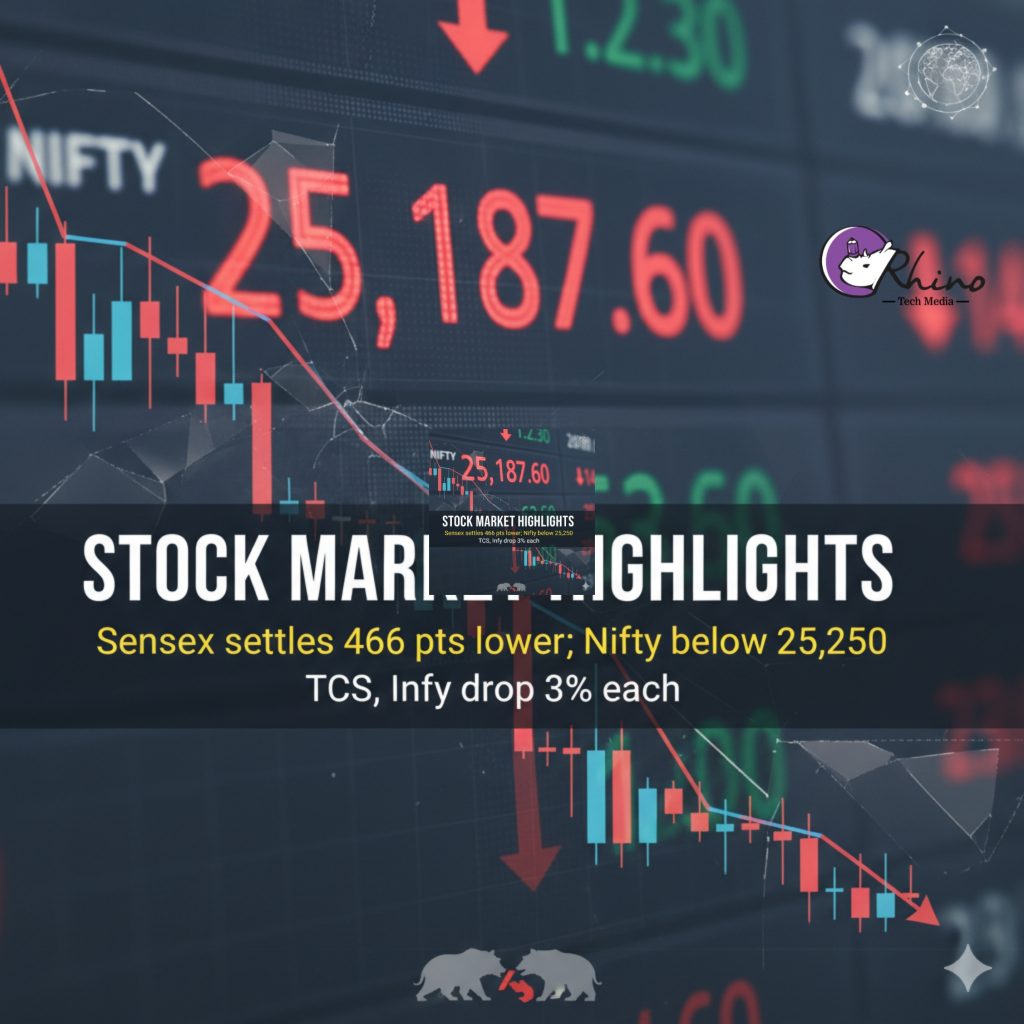Introduction
On 22 September 2025, India’s major stock indices ended in the red. The S&P BSE Sensex dropped by about 466 points (≈0.56%), closing at around ~82,323.62. Meanwhile, the NSE Nifty 50 fell approximately 124.70 points (≈0.49%) to finish at ≈25,202.35, slipping below the important 25,250 level.
Notably, major IT stocks such as Tata Consultancy Services (TCS) and Infosys were among the worst hit, each falling by about 3% amid broader stress in the IT sector.
Key Drivers of the Decline
- U.S. H-1B Visa Fee Hike
A sharp increase in the one-time fee for H-1B visas in the U.S. — reportedly raised to US$100,000 for new visa applications — acted as a catalyst for sell-off in Indian IT stocks. This development heightened concerns about cost structures, staffing flexibility, and competitive positioning for Indian firms that rely heavily on deploying skilled employees to the U.S. market. - Profit Taking After Prior Gains
The market appeared due for some correction. After recent rallies, investors likely saw Monday’s session as an opportunity to lock in gains, especially in sectors that had run up recently (notably IT). Thus, some of the drop may also be attributed to standard market dynamics once valuations or expectations are stretched. - Broader Sectoral Weakness and Global Sentiment
Along with IT, the pharma sector also saw declines (though more moderate), while some defensives or non-IT sectors showed resilience. Also, currency movements (rupee weakening slightly), as well as global headwinds (exchange rates, possibly concerns over U.S. policy) contributed to the cautious tone. - Technical and Psychological Level Breaks
The slip of Nifty below 25,250 is psychologically significant. Markets often react more vigorously around such round or milestone levels. Breaking below that level might have prompted additional selling from technical traders. Support zones were being watched in the 25,000-25,050 range.
Impact on TCS, Infosys and the IT Sector
- Damage to Sentiment: Since TCS and Infosys are among the most visible and heavily weighted IT names, their ~3% falls not only directly pull down the indices but also affect investor confidence in the IT sector at large.
- Cost Pressures: The visa fee hike imposes a new cost burden on any operations involving the U.S. This may reduce margins or force restructuring in staffing/deployment strategies.
- Earnings Forecasts Under Pressure: With higher fixed costs (visa fees etc.), analysts will likely revise down earnings or risk models, which could lead to further downward adjustments in target prices.
- Wider Spillover: Other IT names, especially those with significant U.S. exposure (e.g., Wipro, Tech Mahindra), and perhaps companies in pharma with U.S. regulatory or market linkages, are vulnerable. The decline was not isolated.
Market Breadth and Other Sectors
- Mid-caps & Small-caps: These segments saw sharper declines, reflecting both risk aversion and stronger sensitivity to external shocks. The small and mid-cap indices were down by ~0.7-1.2%.
- Winners & Laggards: While IT and pharma were among the biggest laggards, certain sectors showed strength. For example, power, oil & gas, and metals had relative outperformance or even gains.
- Currency Movement: The rupee weakened slightly against the dollar, adding modest headwinds for importers and companies with dollar-denominated costs.
Implications and What to Watch
- Support Levels: Nifty’s support near 25,000-25,050 will be critical. If the index falls below that, further downside is possible. Conversely, resistance around 25,250-25,400 will now act as a ceiling for short-term recovery attempts.
- IT Sector Strategies: Companies may need to evaluate how much exposure they have to new H-1B visa applications. Some of this may be pass-through cost or could require reorganizing workforce deployment, pushing for more global or offshore staffing.
- Foreign Investment Flows (FIIs/DIIs): How foreign institutional investors respond to this visa fee policy, in conjunction with global interest rate movements, will be crucial. If FIIs start pulling back, it could magnify declines.
- Policy & Regulatory Reactions: Strain may increase demands that the Indian or U.S. government clarify or modify the visa fee rule, especially for existing visa holders or for certain categories of employees. Also, domestic policy moves or incentives might be explored to mitigate the impact.
Conclusion
The markets’ decline on 22 September was triggered primarily by external policy shocks — notably the U.S. H-1B visa fee increase — superimposed on a backdrop of profit taking and stretched valuations. The drop in major IT names like TCS and Infosys signals that even large, relatively resilient stocks are vulnerable in such scenarios, particularly when policy changes affect revenue, cost, or operational models.
Going forward, how the IT sector adapts, how investors recalibrate valuation expectations, and how global policies evolve will be key to whether this dip remains a transient correction or the start of a deeper correction.

